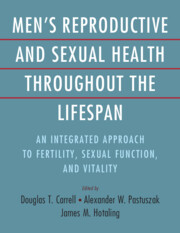 Men's Reproductive and Sexual Health Throughout the Lifespan
Men's Reproductive and Sexual Health Throughout the Lifespan from Section 5 - Medical and Surgical Management of Issues of Male Health
Published online by Cambridge University Press: 06 December 2023
Male erectile dysfunction is a common condition that can significantly impact quality of life and interpersonal relationships. It is strongly associated with aging, comorbid conditions, poor lifestyle, and adverse cardiovascular health. Deficits in psychologic, neurologic, vascular, and endocrine function can all lead to erectile dysfunction. The aim of this chapter is to review the molecular biology required for erectile function as well as delve into the clinical pathophysiology that leads to erectile dysfunction.
To save this book to your Kindle, first ensure [email protected] is added to your Approved Personal Document E-mail List under your Personal Document Settings on the Manage Your Content and Devices page of your Amazon account. Then enter the ‘name’ part of your Kindle email address below. Find out more about saving to your Kindle.
Note you can select to save to either the @free.kindle.com or @kindle.com variations. ‘@free.kindle.com’ emails are free but can only be saved to your device when it is connected to wi-fi. ‘@kindle.com’ emails can be delivered even when you are not connected to wi-fi, but note that service fees apply.
Find out more about the Kindle Personal Document Service.
To save content items to your account, please confirm that you agree to abide by our usage policies. If this is the first time you use this feature, you will be asked to authorise Cambridge Core to connect with your account. Find out more about saving content to Dropbox.
To save content items to your account, please confirm that you agree to abide by our usage policies. If this is the first time you use this feature, you will be asked to authorise Cambridge Core to connect with your account. Find out more about saving content to Google Drive.